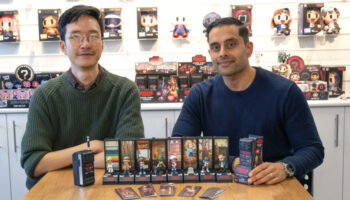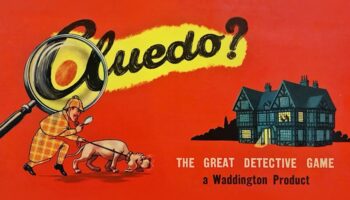Co-inventor David Garrett discusses the HEYKUBE and how it got to market

David Garrett, you’re the co-inventor of HEYKUBE. In a nutshell, what is it?
HEYKUBE is our way of bringing the joy of solving the three-by-three cube puzzle to everyone! There are tons of cubes out in the world, and maybe 99% of the people on the planet have never successfully solved the puzzle. With this, it’s amazing to watch the joy in people’s faces as they pick it up for the first time, scramble it… Then follow the instructions to magically solve what seems to be an impossible puzzle.
Sounds amazing. And this feels intuitive? Even though it’s tech-based?
Yes! We were able to pack into it the most natural interface: rotating lights on the faces of the cube. The lights guide you to the solution… My friend’s five-year-old daughter runs up to him with HEYKUBE, “Scramble it, daddy!” Then she goes off to follow the lights and loves it when it gets back to the solved state. I know it’s a small thing, but having that five-year-old realize even tough problems are solvable can make a difference.
I can imagine. You mention the tons of other cubes out in the world… What makes this one so different?
With the light rings on the cube faces, we’re able to bring many more ways to play with HEYKUBE. First and foremost, though, you don’t need a smartphone or app to play with it. Everything you need is right in front of you. You can think of this as the latest fidget toy or replacement for the Newton’s cradle on your desk.

I’ll never know how Newton slept in one of those things… So the HEYKUBE guides me to the solution. Does it also train me to solve a cube?
Yes – if you take a deeper dive into HEYKUBE, it’s actually showing you the seven-step beginner’s method to learn how to solve the cube yourself. So you can use the lights and sounds to really internalize the patterns – and become a cube master.
I almost daren’t ask – what happens if I make a mistake?
The cube tracks your moves, so if you make a mistake, it can guide you back on track. We’ve also built-in instructions for patterns, such as the cube-in-cube and ‘six spots’… It lets you build some of the neat patterns on the cube.
Sounds great! Anything else?
I guess what we’re most excited about with HEYKUBE is that we’ve opened up a programming interface in Python. Similar to the Arduino and Raspberry Pi platforms, it gives kids a way to have their programs interact with a real object.

I’m assuming the deficiency’s mine, but I don’t have the smallest idea what you’re talking about!
Basically, you can use a Raspberry Pi – a tiny computer – with HEYKUBE, and a programming system, Python library, to control the lights, sounds, and patterns in the cube. It gives cubers a chance to practice different solving algorithms. The long-term goal is to put together a curriculum so that even middle-schoolers could start programming in Python with some very simple constructs that interface with HEYKUBE… Think of programming a game like Hot Potato, and have them graduate to building a custom cube solver with hundreds of patterns like a speed cuber. It’s a powerful way to teach programming, algorithm design, and even trigonometry.
Big plans… So how did the idea come about?
Funny story… I never solved the cube as a kid! I cracked it open with a screwdriver, and I peeled off and replaced the stickers… But I never was able to get it solved. Fast forward to much later in life, I finally wrote a Python program to solve the cube.
Interesting! It started with the programming?
Yes. My good friend Mehdi and I have worked together for the last 15 years… We cooked up the idea that light rings in a cube could teach us how to solve one. Mehdi’s office is amazing, by the way, he’s got every tool you could ever imagine, along with every possible radio-control toy – cars, helicopters, tanks, you name it… Honestly, it was really about working with Mehdi on a fun problem and loving the journey along the way. When the first real-sized HEYKUBE came together, and all the rotations worked, we knew we had something special.

Sounds terrific! What’s your background then, David?
I’m an electrical engineer by day, and I’ve spent the last 25 years building custom semiconductors for wireless signal processing and artificial intelligence processors. I received a PhD in Electrical Engineering at the University of Virginia and spent early parts of my career at Bell Laboratories.
And how did you meet Mehdi?
I met Mehdi working at the CTO office at Broadcom, where Mehdi and I helped deliver billions of WiFi chips to smartphones across the world. These days, I’m the VP of Hardware at Syntiant, a machine learning startup. We train neural networks to recognize voices and provide an ’always-on’ speech interface. My next logical step is to take Syntiant’s ultra-low-power chips for keyword recognition and build a voice interface into HEYKUBE.
In terms of your development process, how did that go? How did you go from notion to motion?!
We knew there’d be some tough challenges. The hard part was being able to feed all six faces of the cube not only with circuits to detect rotation, but also to control and light up the 36 individual LEDs for the light rings… All while letting the six faces freely rotate.

Where did you start with that?
We started with Arduino boards for programming LEDs, sounds, and the solving algorithms. On the mechanical side, we built large-scale cardboard mockups, before we started building 3D printed parts to build the structures of the cube. We went through many variations until we got our first working prototype in the final form factor. It was many nights and weekends in Mehdi’s workshop, soldering tiny wires, and breaking things along the way.
And when you had your first working prototype, what did you do with it?
With the first prototype, my wife – Marcy – joined to help develop the business and take the next big step to a production run. She visited the Chicago Toy Fair in 2019 and met amazing people that gave us great advice, especially important since we were starting cold in the toy business.
Design Edge helped us move from a handful of prototypes, to build the molds and circuits for our first production run. We just kept moving forward in the face of some unexpected hurdles, like the pandemic, and ultimately had the product in hand. It’s sometimes hard to grasp that this idea went from a conversation to a fully-formed gadget ready for consumers.

Brilliant. And am I to understand this was a Kickstarter project? How did you find that experience?
I’ve been fascinated by Kickstarter ever since I bought a Pebble watch early on. We saw it as a great platform to gauge our market and get some funding to build the concept. It was a really exciting time. We had to produce a working prototype for the video, and build out a real business plan around the idea. It became much more than a few people hacking around with demos…
What was the toughest part?
We learned the hard way that Kickstarter requires a lot of pre-launch preparation; to have thousands of people ready to back your project within minutes of its release – which we didn’t do… We knew we had a great product, because of the reaction of people who played with the prototypes. But I guess we were expecting an instant, viral success. It turns out that – even with Kickstarter – creating the magic takes a lot more work. Thankfully, the campaign was a success, funding in four days.
Oh, wow. That’s pretty impressive if you weren’t as prepared as you might have been…
Yes, we were very fortunate. And interacting with our backers has been great! We managed to deliver within a few months of our original date… My neighbor told me we exceeded expectations: he said delivery within a year of the deadline is considered a success on Kickstarter!

Let me ask you this: a number of people might be concerned that this just cashes in on the Rubik’s Cube. How do you handle that?
The Rubik’s Cube is iconic, and obviously a tremendously popular toy. Over the years, many other cubes have entered the market, adding to the popularity of cubing and expanding the types, sizes, shapes, and difficulty. With all the smarts of HEYKUBE, we’re expanding way beyond the basic mechanical puzzle and adding the teaching aspects, the natural interface for hints, and the programming API. We really think of it as a way to amplify the popularity of cubing and bring it into many more households. Think back to the 99% of the world that could never solve the cube!
It does sound like there’s something new there…
Both Mehdi and I have filed hundreds of patents through our work in the tech field, and we have three granted US patents on the HEYKUBE technology. That includes the basic, wireless smart cube idea of tracking the cube and providing solutions, as well as design patents on the light-ring interface. So yes, we’ve really brought something new to refresh this puzzle.
Good answer. What’s next for you?
Really, we’d like to see HEYKUBE in STEM classes in middle schools all over the world. It’s the educational component along with the innovation that gives this toy legs, and it’s a great opportunity for learning. We never set out to create a tech toy business, but as a great mentor told us, “Just keep walking”.

A number of people have said that to me too…
Now that we’ve got the proof of the product, we’re looking for ways to grow HEYKUBE. There’s so much more to building up a company than just getting a cool prototype! We’re working through a number of options to bring HEYKUBE to the next level by putting it into the hands of many more people.
Brilliant. Well, thank you David for your time; very interesting product. Final question – unless it’s not – what’s the most interesting thing in your office or on your desk?
My dad was the navigator and XO in the Navy on an LST during the Vietnam war. I’ve got a framed section of a chart on my wall where – one night in the middle of the Pacific Ocean in 1967 – he took multiple celestial sightings, and created the “pinpoint fix”. After all the calculations and math, all the navigation lines lined up perfectly…
He passed away recently, but I think of that chart often in my work. We spend all this time grinding through our work, calculations, engineering, and struggles, and then, every once in a while, things come together perfectly! But it’s more about the journey, and you get right back out there doing the work again – not knowing if it’s going to be perfect, but definitely striving for it.
Great answer! Fantastic. Thank you again, David; best of luck with the HEYKUBE. Keep us posted on your progress!

—
To stay in the loop with the latest news, interviews and features from the world of toy and game design, sign up to our weekly newsletter here























